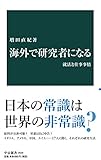私たちはどうつながっているのか: ネットワ-クの科学を応用する (中公新書 1894)
- 中央公論新社 (2007年4月25日発売)
 本棚登録 : 474人
本棚登録 : 474人
 感想 : 63件
感想 : 63件
- Amazon.co.jp ・本 (240ページ)
- / ISBN・EAN: 9784121018946
感想・レビュー・書評
-
07年の本か。出た時に買えばよかった。。
詳細をみるコメント0件をすべて表示 -
「ソーシャル」と上面で言葉を使っているとおそらく注目を払わないけど、次のフェーズを考える人たちにとって基本となる情報ではないでしょうか。
このあたりを理解しているかいないかで、進む道が違ってきちゃう、そういう感じがしています。
※この本自体は2007年刊なので事例がmixiだったりするんですが、でもtwitterもfacebookも世に出る前からこのあたりが書籍として伝えられていたんだ!と驚きます。 -
内容の詰まった良書。社会的ネットワーク関連の本をまとめて読んだけれども、この本が内容・まとまり方・読みやすさ・値段を相対的に見てもCPが高い。
-
ネットワークの本初めてよんだが、序盤はわかりやすくて良かった。
ハブになるための要素の一つは先住すること。 -
「ネットワーク」の視点から日常生活を見直してみると面白い。フェイスブックはどうなっているんだろう、とググってみたら、任意の2人の距離は「3.74次の隔たり」だそうだ。友達の数の中央値はなんと100人。
参考: http://japanese.engadget.com/2011/11/24/facebook-3-74/ -
(スエーデンの大学院で学んでいた時分に、学内のポータルにアップしていたものを引っ越しています)
The book describes how we are connected in terms of relationship. If we count a distance from us to someone we can directly contact as one step, almost anyone in the world can be reached within 6 steps. Especially when there is a shortcut between communities, the steps can be substantially shorter. We are living in a small world.
Since each of of us belong to several communities at the same time, such as a family, workplace, schools attended, sports clubs, SNSs, etc., our info gathering tend to be limited in terms of quality. When we can reach a community with which we don't have much connection, and especially someone who is not in a strongly bonded community/cluster, the author claims there is a better chance for new info to come into our views.
The author shows a shortcut from us to someone in a distance plays an important role in networking, which shorten the steps needed to reach someone in a distance to a large extent.
Having such a shortcut doesn't have to be our owns. We can also use someone's shortcuts when we know such persons.
The author also shows networking involves free scaling, meaning someone in the network has more nodes than others (like relatively a small percentage of people are very rich than others). Such a person with a lot of nodes is called a hub. A person in a hub place can be very powerful since a lot of information go through a hub but it also takes some costs to keep on existing as a hub.
I expected a lot of insights in networking with others but what the author showed in this book is nothing more than common sense or correct intuition. This boring contents can be that the author intentionally tried to avoid complicated arguments (and avoid any mathematics) and explained things as much simple as possible. I think that attempt failed and as a consequence the book became a “So what?”book. -
第4週 2/1(水)~2/7/(火)
テーマ メディアとコミュニケーション
↓貸出状況確認はこちら↓
https://opac2.lib.nara-wu.ac.jp/webopac/BB00152522 -
安田雪さんの「人脈づくりの科学」と内容は似通ってますが、こっちの方が簡単にわかりやすくまとめてくれてます。絵もあるしね(笑)やっぱりネットワークはほどほどが一番。ということですかね…
-
六次の隔たりとか、弱い紐帯とか人のネットワークの話。
様々な理論をつかいながら、やみくもにネットワークのではなく、自分にあったかたちで、効率的に人脈を広げましょうと。 -
本書は「ネットワーク」の概念について解説しているが、TCP/IPに代表されるインターネット等について書かれているわけではない。古来からの「グラフ理論」、「複雑ネットワーク」の学問で研究されてきた『人的ネットワーク』についてだ。
ある意味、mixiやfacebook、その他SNSのみで完結するような希薄なネットワークに警鐘を鳴らしている一冊といえるかもしれない。
スモールワールド(6次の隔たり)、クラスター、スケールフリー・ネットワークについての概念がよく分かる。
クラスターとは分かりやすく言えば、自分が属する組織、コミュニティ、人間関係のことを指す。自分が携わる仕事で満足のいく成果を残したり、他人との関わりで豊かな人生を送りたいならば、自分の人的ネットワークを構築する必要がある。
翻っていえば、「ネットワーク」というものは自分で選択し、構築できるものであるということである。更にいうならば、自分の置かれているネットワークの棚卸しをして見直しをかけることが必要であり、現状に甘んじていては自己成長も望めないことだと解釈した。
もちろん、現状自分の属するネットワークに大満足している人はその限りではない。
スケールフリー・ネットワークの考え方は、まだ未知の部分が多いが自分がネットワークのハブになる、ならない、どの程度までなるか、というトレードオフについての記述は非常に参考になった。
自分の中の「アナログ的」部分を見直すきっかけを与えてくれる良書である。
著者プロフィール
増田直紀の作品


























![[まとめ買い] 経済セミナーe-Book](https://m.media-amazon.com/images/I/B1ZR7JGF-dS._SL160_.png)


